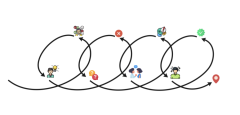At the very beginning, when I needed to choose something in my uncertainty box, the direction I chose was how to develop art students’ careers. The question is: How can art graduates build their careers in the Internet age?
After I interviewed my previous classmates, and I found that the original question is that they chose the wrong major. My question then became: How can art students choose the right subject to help them define themselves and find suitable jobs after graduation?
After that, I researched the UAL foundation course, UAL outreach program, and UAL insights. I thought the foundation course is quite similar to what I want to do. But this course is mainly for that student who 1) would like to spend one year 2) can afford it. So I will specifically focus on other student groups. For example, I can create an online platform and collect lots of information to help them choose the right subject. Then I realized that I’m more of an information provider, and the most important thing is that they lack the awareness of choosing majors carefully. If they have the attention, they can gather relevant information by themselves, which is not that hard in this internet age. So my question became: How can I Awaken students’ awareness of choosing majors carefully?
Later, I discussed it with the dragon team. It made me thought more about: there are so many art graduates every year, but not everyone can become an artist. Should we do what we love or love what we do? Art students are more likely to feel uneasy in the face of employment problems because they are a group of sensitive and ambitious people. My question change again: How can I reduce art students’ psychological gap when facing employment problems?
When I think about it, I want to convey that we should accept our ordinariness and not have too many unrealistic fantasies. But at the same time, I think it’s negative. I still want to do some positive things and help ambitious students to build their careers. Then I found UAL’s Enterprise Programme, which is a creative business accelerator program. Due to my interests about ‘personal IP’ and ‘freelancer’, now my question is: How can I help art students who want to be a freelancer build personal IP in the Internet age?
